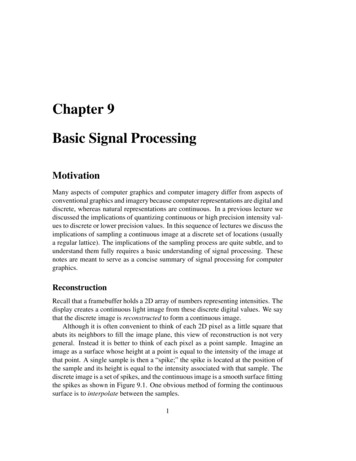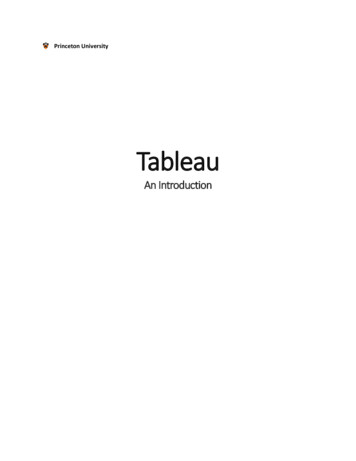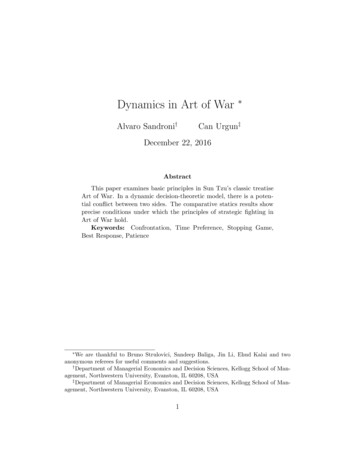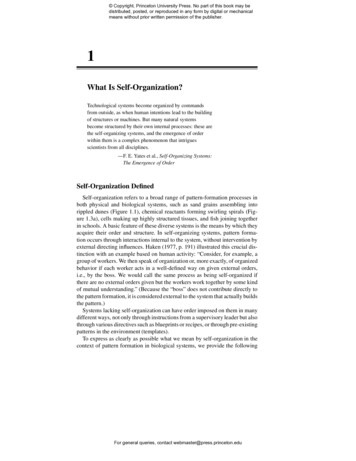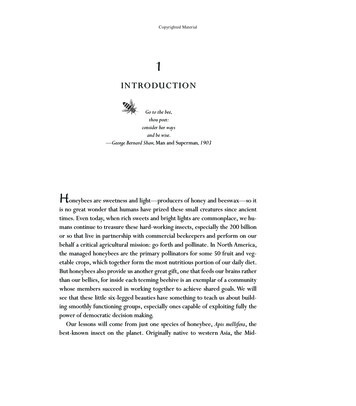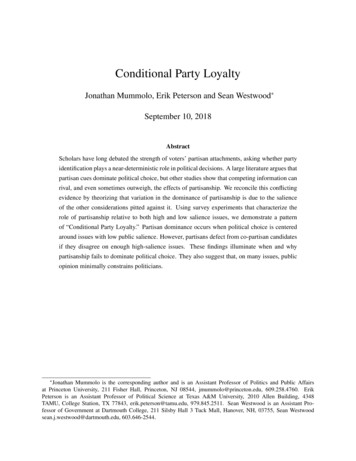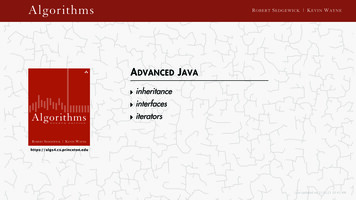
Transcription
AlgorithmsR OBERT S EDGEWICK K EVIN W AYNEA DVANCED J AVA‣ inheritance‣ interfacesAlgorithmsF O U R T H‣ iteratorsE D I T I O NR OBERT S EDGEWICK K EVIN W AYNEhttps://algs4.cs.princeton.eduLast updated on 2/10/21 10:41 AM
Advanced JavaSubtitle. Java features that we (occasionally) use in this course, but don’t cover (much) in COS n theme: promote code reuseQ. How to take your Java to the next e8/jls8.pdf2
A DVANCED J AVA‣ inheritance‣ interfacesAlgorithmsR OBERT S EDGEWICK K EVIN W AYNEhttps://algs4.cs.princeton.edu‣ iterators
MotivationQ1. How did the Java architects design System.out.println(x) so thatit works with all reference types?Q2. How would an Android developer create a custom Java GUI text component,without re-implementing these 400 required methods?A. Inheritance.action() add() addAncestorListener() addCaretListener() addComponentListener() addContainerListener() addFocusListener() addHierarchyBoundsListener() addHierarchyListener() addImpl() addInputMethodListener() addKeyListener() addKeymap() addMouseListener() addMouseMotionListener() addMouseWheelListener() addNotify() addPropertyChangeListener() addVetoableChangeListener() applyComponentOrientation() areFocusTraversalKeysSet() bounds() checkImage() coalesceEvents() computeVisibleRect() contains() copy() countComponents() createImage() createToolTip() createVolatileImage() cut() deliverEvent() disable() disableEvents() dispatchEvent() doLayout() enable() enableEvents() enableInputMethods() findComponentAt() fireCaretUpdate() firePropertyChange() fireVetoableChange() getActionForKeyStroke() getActionMap() getAlignmentX() getAlignmentY() getAncestorListeners() getAutoscrolls() getBackground() getBaseline() getBaselineResizeBehavior() getBorder() getBounds() getCaret() getCaretColor() getCaretListeners() getCaretPosition() getClientProperty() getColorModel() getComponent() 4
Inheritance overviewImplementation inheritance (subclassing).・Define a new class (subclass) from another class (base class or superclass).・The subclass inherits from the base class:– instance variables (state)– instance methods (behavior)・The subclass can override instance methods in the base class (replacing with own versions).Main benefits.・Facilitates code reuse.・Enables the design of extensible libraries.5
Inheritance examplepublic class Disc {protectedimport java.awt.Color;int x, y, r;public class ColoredDisc extends Disc{public Disc(int x, int y, int r) {this.x x;protected Color color;inherited by subclassthis.y y;this.r r;defines new statepublic ColoredDisc(int x, int y, int r, Color color) {}super(x, y, r);calls constructor in base classthis.color color;public double area() {}return Math.PI * r * r;}public Color getColor() {defines new behaviorreturn color;public boolean intersects(Disc that) {}int dx this.x - that.x;int dy this.y - that.y;overrides methodin base classpublic void draw() {int dr this.r that.r;StdDraw.setPenColor(color);return dx*dx dy*dy dr*dr;StdDraw.filledCircle(x, y, r);}}public void draw() {StdDraw.filledCircle(x, y, r);}subclass}}base class6
Inheritance demo (in JShell) /Desktop/advanced-java jshell-algs4/open Shape2D.java/open Disc.java/open ColoredDisc.javaStdDraw.setScale(0, 800);Disc disc1 new Disc(400, 400, 200);disc1.area();disc1.draw();ColoredDisc disc2 new ColoredDisc(225, 575, 100, StdDraw.BLUE);ColoredDisc disc3 new ColoredDisc(575, 575, 100, ntersects(disc3);Disc disc disc2;// downcastdisc.area();7
Advanced Java: quiz 1Which color will be stored in the variable color?Disc disc new ColoredDisc(200, 300, 100, StdDraw.BLUE);Color color disc.getColor();A.Blue.B.Black.C.Compile-time error.a variable of type Disc can call only Disc methods(even if it holds a reference to a ColoredDisc)D.E.Run-time error. 8
PolymorphismSubtype polymorphism. A subclass is a subtype of its superclass:objects of the subtype can be used anywhere objects of the superclass are allowed.RHS of assignment statement,method argument, return value, expression, .Ex. A reference variable can refer to any object of its declared type or any of its subtypes.Disc disc new ColoredDisc(x, y, r, color);variable ofobject of typetype DiscColoredDiscpointing to andouble area disc.area();boolean disc.intersects(disc);Color color disc.getColor();can call only Disc methods(compile-time error)9
PolymorphismDynamic dispatch. Java determines which version of an overridden method to callusing the type of the referenced object at runtime (not necessarily the type of the variable).Disc disc new ColoredDisc(x, y, r, color);variable ofobject of typetype DiscColoredDiscdisc.draw();pointing to ancalls ColoredDisc version of draw()a “polymorphic” method call10
Subclass hierarchy for Java GUI componentsTypical use case. Design an extensible library.Ex. Android developer design a new GUI widget for their getJAppletJava GUI class hierarchyDialogFrameFileDialogJFrameSubclass inheritance hierarchy for GUI components (partial)11
IS-A relationshipInformal rule. Inheritance should represent an IS-A relationship.subclassbase alaxyS10SmartPhoneBarbara LiskovTuring Award 2008Liskov substitution principle. Subclass objects must always be substitutablefor base class objects, without altering desirable properties of program.12
Java’s Object superclassObject data type. Every class has Object as a (direct or indirect) superclass.public class Disc extendsextends ObjectObject.{added implicitly(if no extends barIntegerDoubleJava class hierarchyDiscBigInteger.ColoredDisc13
Java’s Object superclassObject data type. Every class has Object as a (direct or indirect) superclass.public class ObjectString toString()boolean equals(Object x)int hashCode()string representationis this object equal to x ?hash code of this objectClass getClass()runtime class of this object.copying, garbage collection, concurrencyInherited methods. Often not what you want override them.・Equals: reference equality (same as ).・Hash code: memory address of object.・String representation: name of class, followed by @, followed by memory address.14
The toString() methodBest practice. Override the toString() method.public class Disc {protected int x, y, r;without overriding toString() method /Desktop/inheritance jshell-algs4/open Disc.javaDisc disc new Disc(100, 100, 20);StdOut.println("disc " disc.toString());.disc Disc@239963d8public String toString() {return String.format("(%d, %d, %d)", x, y, r);}works like printf() but returns string}after overriding toString() methoddisc (100, 100, 20)(instead of printing it)String concatenation operator. Java implicitly calls object’s toString() method.StdOut.println("disc " disc);string concatenation operator15
Inheritance summarySubclassing. Powerful OOP mechanism for code reuse.Limitations.・Violates encapsulation.・Stuck with inherited instance variables and methods forever.・Subclasses may break with seemingly innocuous change to superclass.Best practices.・Use with extreme care.・Favor composition (or interfaces) over subclassing.This course.・Yes: override inherited methods:・No: define subclass hierarchies.toString(), hashCode(), and equals().16
A DVANCED J AVA‣ inheritance‣ interfacesAlgorithmsR OBERT S EDGEWICK K EVIN W AYNEhttps://algs4.cs.princeton.edu‣ iterators
MotivationQ1. How to design a single method that can sort arrays of strings, integers, or dates?Q2. How to iterate over a collection without knowing the underlying representation?Q3. How to intercept and process mouse clicks in a Java app?A. Java interfaces.String[] a { "Apple", "Orange", "Banana" };Stack String new Stack Whitman");Integer[] b { 3, 1, 2 };stack.push("Mathey");Arrays.sort(b);for (String s : stack)sort arraysStdOut.println(s);iterate over a collection18
Java interfaces overviewInterface. A set of methods that define some behavior (partial API) for a class.public class Disc implements Shape2Dprotected int x, y, r;public interface Shape2D {void draw();boolean contains(int x0, int y0);class promises tohonor the contract{public Disc(double x, double y, double r) {this.x x;this.y y;this.r r;}}the contract: methods with these signatures(and prescribed behaviors)public void draw() {StdDraw.filledCircle(x, y, r);}class abides bythe contractpublic boolean contains(int x0, int y0) {int dx x - x0;int dy y - y0;return dx*dx dy*dy r*r;}class can defineadditional methodspublic boolean intersects(Disc that) {.}}19
Java interfaces overviewInterface. A set of methods that define some behavior (partial API) for a class.public interface Shape2D {void draw();boolean contains(int x0, int y0);public class Square implements Shape2D {.}}the contract: methods with these signatures(and prescribed behaviors)Many classes can implement the same interface.public class Triangle implements Shape2D {.}public class Star implements Shape2D {.}public class Heart implements Shape2D {.}20
Java interfaces demo (in JShell) /Desktop/inheritance jshell-algs4/open Shape2D.java/open Disc.java/open Square.java/open Heart.javaShape2D disc new Disc(400, 700, 100);Shape2D square new Square(400, 400, 200);Shape2D heart new Heart(400, 400, 100);Shape2D s "Hello, World";implicit type conversion(upcasting)// compile-time error (incompatible types)disc.draw();disc.contains(400, 300);disc.area();// compile-time error (not a Shape2D method)Shape2D[] shapes { disc, square, heart };for (int i 0; i shapes.length; i )shapes[i].draw();21
Java interface propertiesInterfaces are reference types. Can declare variables or uses as argument/return types.Subtype polymorphism. A class that implements an interface is a subtype of that interface:objects of the subtype can be used anywhere objects of the interface are allowed.RHS of assignment statements, method arguments, return types, .Key differences with inheritance.・Uses keyword implements instead of extends.・No instance variables or instance methods inherited.・Multiple inheritance: a class can implement many interfaces (but extend only one class).public class MovableDisc extends Disc implements Shape2D, Movable {.}22
Advanced Java: quiz 2Which of the following statement(s) leads to a compile-time error?A.Shape2D shape new Shape2D();B.Shape2D[] shapes new Shape2D[10];C.Both A and B.D.Neither A nor B.can construct objects of concrete classes only (not interfaces)creates an array of references to objects of type Shape2D23
Java interfaces in the wildInterfaces are essential for industrial-strength programming in Java.purposebuilt-in paratorthis etGUI cyjava.lang.Runnablejava.lang.Callable24
Java interfaces summaryJava interface. A set of methods that define some behavior (partial API) for a class.Design benefits.・Enables callbacks, which promotes code reuse.・Facilitates lambda expressions.This course.・Yes: use interfaces built into Java (for sorting and iteration).・No: define our own interfaces; lambda expressions.25
A DVANCED J AVA‣ inheritance‣ interfacesAlgorithmsR OBERT S EDGEWICK K EVIN W AYNEhttps://algs4.cs.princeton.edu‣ iterators
IterationDesign challenge. Allow client to iterate over items in a collection (e.g., a stack),without exposing its internal representation.stack (resizing-array ull0123456789stack (linked-list va solution. Use a foreach loop.27
Foreach loopJava provides elegant syntax for iterating over items in a collection.“foreach” loop (shorthand)equivalent code (longhand)Stack String stack new Stack ();.Stack String stack new Stack ();.for (String s : stack) {.}Iterator String iterator stack.iterator();while (iterator.hasNext()) {String s iterator.next();.}To make user-defined collection support foreach loop:・Data type must have a method named iterator().・The iterator() method returns an Iterator object that has two core method:– the hasNext() methods returns false when there are no more items– the next() method returns the next item in the collection28
Iterator and Iterable interfacesJava defines two interfaces that facilitate foreach loops.・ Iterable interface:・ Iterator interface:iterator() method that returns an Iterator.next() and hasNext() methods.・Each interface is generic.java.lang.Iterable interface“I am a collection that can be traversed with a foreach loop”“I represent the state of one traversal”(supports multiple iterators over the same collection)java.util.Iterator interfacepublic interface Iterable Item Iterablepublic interface Iterator Item Iterator{{Iterator iterator();Iterator Item iterator();boolean hasNext();}Item next();}Type safety. Foreach loop won’t compile unless collection is Iterable (or an array).29
Stack iterator: array implementationimport java.util.Iterator;public class ResizingArrayStack Item {.implements Iterable Item public Iterator Item iterator() { return new ReverseArrayIterator(); }private class ReverseArrayIterator implements Iterator Item {private int i n-1;// index of next item to returnpublic boolean hasNext() {public Item next(){return i 0;return s[i--];}}}}s[]Note: next() must throw a NoSuchElementException if called when no more items in 678930
Stack iterator: linked-list implementation (in IntelliJ)import java.util.Iterator;public class LinkedStack Item {.implements Iterable Item public Iterator Item iterator() { return new LinkedIterator(); }private class LinkedIterator implements Iterator Item {private Node current first;public boolean hasNext() {return current ! null;public Item next(){Item item current.item;current current.next;return item;}}Note: next() must throw aNoSuchElementExceptionwhen called withno more items in iteration}}firstcurrent!todaydreamahaveInull31
Advanced Java: quiz 3Suppose that you add A, B, and C to a stack (linked list or resizing array), in that order.What does the following code fragment do?for (String s : stack)for (String t : stack)StdOut.println(s "-" t);A.Prints A-A A-B A-C B-A B-B B-C C-A C-B C-CB.Prints C-C B-B A-Aeach iterator has its own instance variablesC.Prints C-C C-B C-AD.Prints C-C C-B C-A B-C B-B B-A A-C A-B A-AE.Depends upon implementation.(so can iterate independently)32
Advanced Java: quiz 4Suppose that you add A, B, and C to a stack (linked list or resizing array), in that order.What does the following code fragment do?for (String s : ));stack.push(s);}A.Prints A A B B C CB.Prints C C B B A AC.Prints C C B C A BD.Prints C C C C C C C C .E.Depends on implementation.LinkedStack and ResizingArrayStacklesson: don’t modify a collectionwhile iterating over it33
ITERATION:CONCURRENT MODIFICATIONQ. What should happen if a client modifies a collection while iterating over it?A. A fail-fast iterator throws a nt modificationfor (String s : stack)stack.push(s);Q. How to detect concurrent modification?A.・Count total number of push() and pop() operations in Stack.・Save counts in *Iterator subclass upon creation.・If, when calling either next() or hasNext(), the current countsdo not equal the saved counts, throw exception.34
Java iterators summaryIterator and Iterable. Two Java interfaces that allow a client to iterate over items in a collectionwithout exposing its internal representation.Stack String stack new Stack ();.for (String s : stack) {.}This course.・Yes:・Yes:use iterators in client code.implement iterators (Assignment 2 only).35
Copyright 2021 Robert Sedgewick and Kevin Wayne36
Feb 10, 2021 · Implementation inheritance (subclassing). ・Define a new class (subclass) from another class (base class or superclass). ・The subclass inherits from the base class: – instance variables (state) – instance methods (behavior) ・The subclass can override instance methods in the base class (replacing wi

